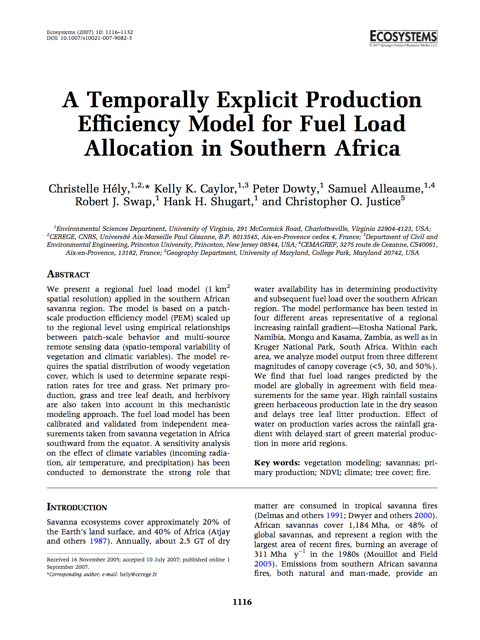A temporally explicit Production Efficiency Model for fuel load allocation in southern Africa

Hély C., K.K. Caylor, P.R. Dowty, S. Alleaume, R.J. Swap, H.H. Shugart, C.O. Justice (2007) “A temporally explicit Production Efficiency Model for fuel load allocation in southern Africa,” Ecosystems, doi: 10.1007/s10021-007-9082-3.
We present a regional fuel load model (1 km(2) spatial resolution) applied in the southern African savanna region. The model is based on a patch-scale production efficiency model (PEM) scaled up to the regional level using empirical relationships between patch-scale behavior and multi-source remote sensing data (spatio-temporal variability of vegetation and climatic variables).
The model requires the spatial distribution of woody vegetation cover, which is used to determine separate respiration rates for tree and grass. Net primary production, grass and tree leaf death, and herbivory are also taken into account in this mechanistic modeling approach. The fuel load model has been calibrated and validated from independent measurements taken from savanna vegetation in Africa southward from the equator. A sensitivity analysis on the effect of climate variables (incoming radiation, air temperature, and precipitation) has been conducted to demonstrate the strong role that water availability has in determining productivity and subsequent fuel load over the southern African region. The model performance has been tested in four different areas representative of a regional increasing rainfall gradient-Etosha National Park, Namibia, Mongu and Kasama, Zambia, as well as in Kruger National Park, South Africa. Within each area, we analyze model output from three different magnitudes of canopy coverage (< 5, 30, and 50%).
We find that fuel load ranges predicted by the model are globally in agreement with field measurements for the same year. High rainfall sustains green herbaceous production late in the dry season and delays tree leaf litter production. Effect of water on production varies across the rainfall gradient with delayed start of green material production in more arid regions.
